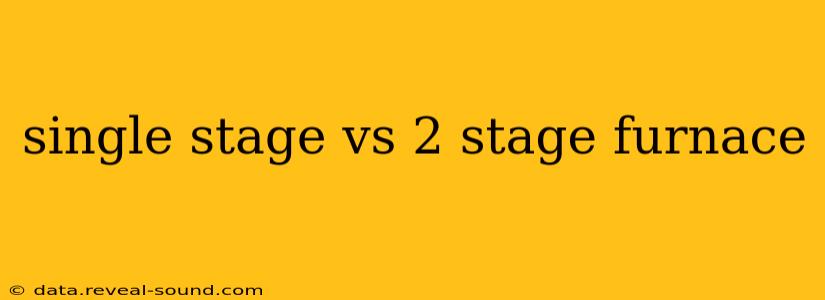Choosing the right furnace is a crucial decision for homeowners, impacting both comfort and energy bills. Two main types dominate the market: single-stage and two-stage furnaces. Understanding their differences is key to making an informed choice. This comprehensive guide will delve into the specifics of each, helping you determine which furnace best suits your needs and budget.
What is a Single-Stage Furnace?
A single-stage furnace operates on a simple "on-off" system. It either runs at full capacity or is completely off. Think of it like a light switch – it's either on or off, there's no in-between. This simplicity translates to a lower initial cost, making it a budget-friendly option. However, this all-or-nothing approach can lead to temperature fluctuations and less efficient heating. When the thermostat calls for heat, the blower and burner ignite at full power, and remain that way until the desired temperature is reached, then shuts off completely.
Advantages of Single-Stage Furnaces:
- Lower initial cost: Single-stage furnaces generally have a lower purchase price compared to two-stage models.
- Simplicity: Their straightforward design often leads to easier maintenance and repairs.
Disadvantages of Single-Stage Furnaces:
- Temperature swings: The abrupt on/off cycling can result in noticeable temperature fluctuations throughout your home.
- Less efficient: The constant full-power operation can be less energy-efficient than two-stage models, leading to higher energy bills in the long run.
- Shorter lifespan: The constant cycling can put more stress on the components, potentially leading to a shorter lifespan.
What is a Two-Stage Furnace?
A two-stage furnace offers a more refined approach to heating. It operates at two different capacity levels: a lower "low-fire" mode and a higher "high-fire" mode. The furnace intelligently switches between these stages to maintain a more consistent temperature. Think of it like a dimmer switch – it can provide gentle warmth or intense heat as needed. This nuanced control leads to greater comfort and potentially improved energy efficiency.
Advantages of Two-Stage Furnaces:
- More consistent temperature: The ability to modulate between high and low settings leads to fewer temperature fluctuations, providing a more comfortable living environment.
- Improved energy efficiency: By running at a lower capacity for longer periods, two-stage furnaces can be more energy-efficient, potentially saving you money on your energy bills.
- Better humidity control: The gentler heating provided by the low-fire mode can help maintain better humidity levels in your home, leading to improved indoor air quality.
- Longer lifespan: The reduced stress on components from less frequent cycling can contribute to a longer furnace lifespan.
Disadvantages of Two-Stage Furnaces:
- Higher initial cost: Two-stage furnaces typically have a higher purchase price compared to single-stage models.
- More complex design: This can sometimes lead to slightly more complex maintenance and repairs.
Which Type of Furnace is Right for Me?
The best furnace for your home depends on several factors:
- Budget: Single-stage furnaces are more budget-friendly upfront, while two-stage furnaces offer long-term savings through energy efficiency.
- Climate: In milder climates, the energy savings of a two-stage furnace may be less significant.
- Home size and insulation: Well-insulated homes may not require the precise temperature control offered by a two-stage furnace.
- Comfort preferences: If consistent temperature is a priority, a two-stage furnace may be worth the investment.
How Much Does a Two-Stage Furnace Cost?
The cost of a two-stage furnace varies depending on several factors including the size, brand, and features. Generally, you can expect to pay more for a two-stage unit than a single-stage unit. The additional cost is usually offset over time by energy savings.
What are the Differences Between a Single Stage and a Variable Speed Furnace?
A variable-speed furnace goes a step further than a two-stage furnace. While a two-stage furnace has two distinct settings, a variable-speed furnace offers a much wider range of operating speeds, allowing for even finer temperature control and potentially greater energy savings. It's the top-tier option in terms of comfort and efficiency but also comes with the highest initial cost.
How Long Does a Single Stage Furnace Last?
The lifespan of a single-stage furnace typically ranges from 15 to 20 years, though this can vary depending on usage, maintenance, and the quality of the unit. Regular maintenance can significantly extend its lifespan.
Is a Two-Stage Furnace Worth the Cost?
The value of a two-stage furnace depends on your individual needs and priorities. While the initial cost is higher, the improved comfort, energy efficiency, and potentially longer lifespan can make it a worthwhile investment in the long run, especially for those prioritizing comfort and energy savings. Carefully weigh the pros and cons and consider your budget and long-term goals. A consultation with an HVAC professional can help you make the best decision for your specific situation.
